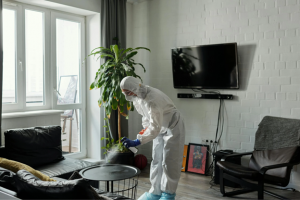Asbestos, a group of naturally occurring minerals, was once widely used in construction materials due to its durability and resistance to heat. However, it is now known to be a serious health hazard, causing diseases such as mesothelioma, lung cancer, and asbestosis. Protecting yourself and your family from asbestos exposure at home is crucial. This guide will help you identify the presence of asbestos in your home and provide steps for safe removal.
Identifying Asbestos in Your Home
To identify asbestos, you need to know where it might be hiding. Asbestos was commonly used in building materials before the 1980s. These materials include insulation, floor tiles, ceiling tiles, roofing shingles, cement products, and even textured paints. Begin by inspecting areas such as attics, basements, and older floor coverings. Look for materials that appear old or worn, and take special care with any that are damaged or deteriorating.
If you suspect a material contains asbestos, avoid disturbing it. Asbestos fibers are hazardous when airborne, and inhalation is the primary route of exposure. Instead, take a sample for testing. Wear a mask and gloves, carefully cut a small piece of the material, and seal it in a plastic bag. Send the sample to a certified asbestos testing laboratory for analysis.
Understanding Health Risks
Exposure to asbestos fibers can lead to severe health problems. When inhaled, these fibers can become lodged in the lungs, causing inflammation and scarring. Over time, this can develop into serious conditions such as mesothelioma, a cancer of the lining of the lungs or abdomen, and lung cancer. Other diseases include asbestosis, a chronic lung disease that causes shortness of breath and permanent lung damage.
Symptoms of asbestos-related diseases often do not appear until many years after exposure. Common signs include persistent coughing, chest pain, and difficulty breathing. If you have been exposed to asbestos and experience these symptoms, seek medical attention promptly. Early detection can improve treatment outcomes.
Assessing the Need for Professional Help
While some minor asbestos removal tasks can be done by homeowners, many situations require professional intervention. If the asbestos-containing material is damaged or if a large area is involved, it is best to call in the experts. Professional asbestos removal companies have the necessary equipment and expertise to handle the material safely and comply with local regulations.
When choosing a professional, look for licensed and certified contractors. Research the types of asbestos companies in New York, as this will provide you with a range of reputable firms to consider. Check reviews, ask for references, and ensure the company has a good safety record. Professionals will also manage the disposal of asbestos waste, which must be handled according to strict guidelines to prevent environmental contamination.
Safe Removal Procedures
If you decide to tackle a small asbestos removal project yourself, follow strict safety protocols. First, gather the necessary protective gear, including a high-efficiency particulate air (HEPA) respirator, disposable coveralls, gloves, and eye protection. Seal off the work area with plastic sheeting to prevent asbestos fibers from spreading to other parts of your home.
Wet the asbestos-containing material thoroughly before disturbing it. This reduces the release of fibers into the air. Carefully remove the material, keeping it intact as much as possible. Place the removed material in heavy-duty plastic bags, seal them, and label them as hazardous waste.
Legal and Environmental Considerations
Asbestos removal and disposal are subject to strict regulations. These laws are designed to protect public health and the environment. Before starting any removal project, check local regulations to ensure compliance. In many areas, you must notify local authorities of your intent to remove asbestos and follow specific procedures for disposal.
Improper disposal of asbestos can result in severe penalties. Asbestos waste must be taken to a designated disposal facility, where it will be handled in a manner that prevents environmental contamination. Always transport asbestos waste in sealed containers and ensure it is clearly labeled. By adhering to these regulations, you contribute to the safety of your community and the environment.
Maintaining a Safe Home Environment
After asbestos removal, it is essential to take steps to maintain a safe home environment. Regularly inspect areas where asbestos-containing materials were present to ensure no residual fibers remain. Use a HEPA vacuum to clean these areas periodically. If you plan to renovate or remodel your home, check for asbestos before starting any work, especially if the house was built before the 1980s.
Consider having your home inspected by a professional periodically, particularly if you live in an older house. This will help you identify any potential asbestos issues early and address them before they become a health hazard. Educate your family about the dangers of asbestos and the importance of avoiding exposure. By staying vigilant, you can protect your home and your health.
Identifying and removing asbestos from your home is a critical step in ensuring a safe living environment. By understanding where asbestos might be found, recognizing the health risks, and knowing when to call in professionals, you can effectively manage this hazard. Following safe removal procedures and adhering to legal requirements will protect you, your family, and the environment from the dangers of asbestos. Regular maintenance and vigilance will help you maintain a healthy home for years to come.


